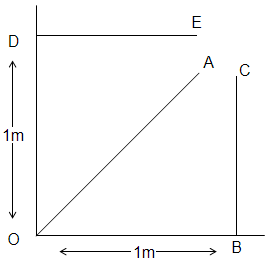A particle of mass m moves with a constant velocity
along 3 different paths, DE, OA and BC. Which of the following statements is not correct about its angular momentum about point O?


1.
It is zero when it is at A and moving along OA.
2.
The same at all points along the line DE.
3.
Of the same magnitude but oppositely directed at B and D.
4.
Increases as it moves along the line BC.


A sphere is rolling down a plane of inclination to the horizontal. The acceleration of its centre down the plane is
1. g sin
2. less than g sin
3. greater than g sin
4. zero
A bob of mass m attached to an inextensible string of length l is suspended from vertical support. The bob rotates in a horizontal circle with an angular speed about the vertical. About the point of suspension.
| 1. | Angular momentum is conserved |
| 2. | Angular momentum changes in magnitude but not in the direction |
| 3. | Angular momentum changes in direction but not in magnitude |
| 4. | Angular momentum changes both in direction and magnitude |
In free space, a rifle of mass \(M\) shoots a bullet of mass \(m\) at a stationary block of mass \(M\) at a distance \(D\) away from it. When the bullet has moved through a distance \(d\) towards the block, the centre of mass of the bullet-block system is at a distance of:
1. \(\frac{D-d}{M+m}~\text{from the bullet}\)
2. \(\frac{md+ MD}{M+m}~\text{from the block}\)
3. \(\frac{2md+ MD}{M+m}~\text{from the block}\)
4. \(\frac{(D-d)M}{M+m}~\text{from the bullet}\)
Blocks A and B are resting on a smooth horizontal surface given equal speeds of 2 m/s in the opposite sense as shown in the figure.

At t = 0, the position of blocks are shown, then the coordinates of centre of mass at t = 3s will be
1. (1, 0)
2. (3, 0)
3. (5, 0)
4. (2.25, 0)
A wheel is at rest. Its angular velocity increases uniformly and becomes 80 rad/s after 5 s. The total angular displacement is
1. 800 rad
2. 400 rad
3. 200 rad
4. 100 rad
A force\(- F \hat k\) acts on O, the origin of the coordinate system. The torque at the point (1, -1) will be:
1.
2.
3.
4.
Moment of inertia of an object does not depend upon
| 1. | mass of object |
| 2. | mass distribution |
| 3. | angular velocity |
| 4. | axis of rotation |
A thin uniform circular disc of mass \(M\) and radius \(R\) is rotating in a horizontal plane about an axis passing through its center and perpendicular to its plane with an angular velocity . Another disc of the same dimensions but of mass \(\frac{1}{4}M\) is placed gently on the first disc co-axially. The angular velocity of the system will be:
| 1. | 2. | ||
| 3. | 4. |






